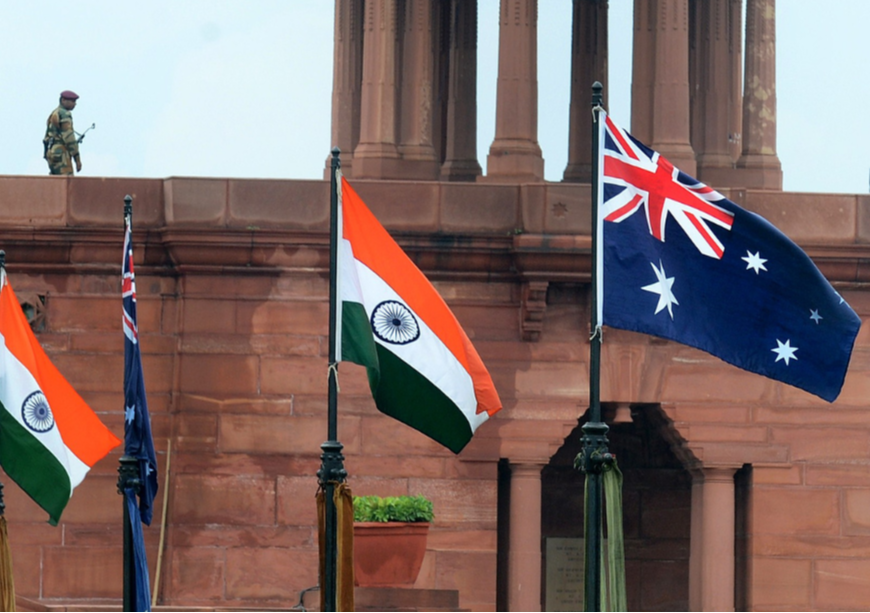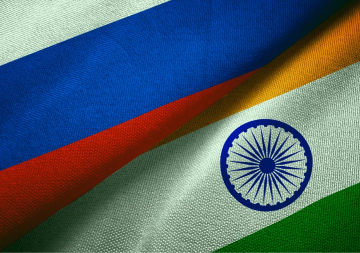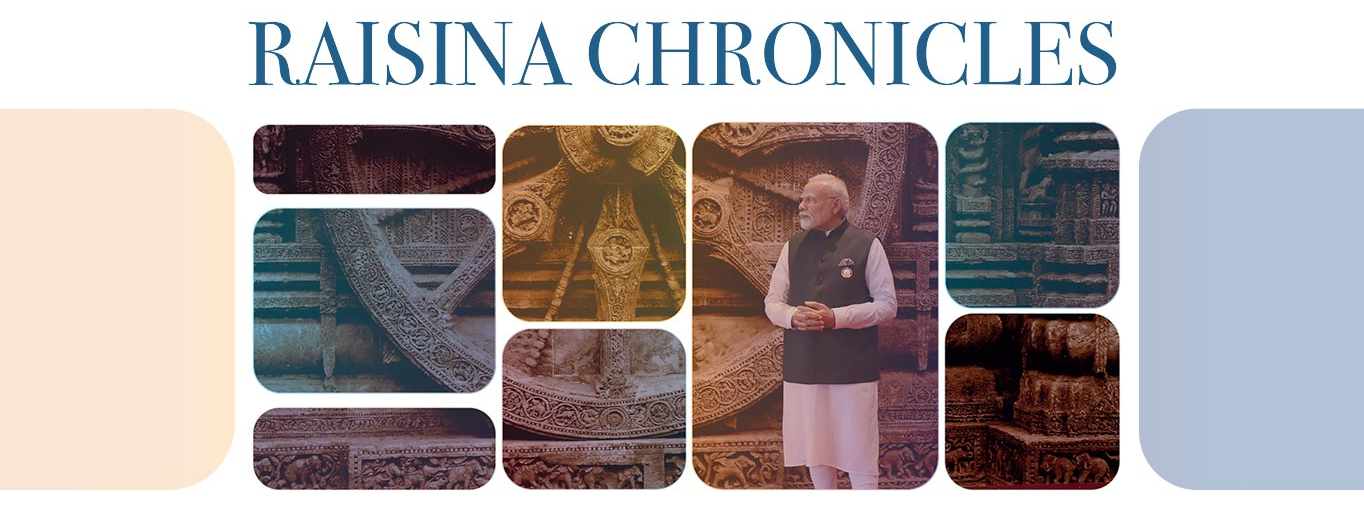
This article is a part of the series - Raisina Chronicles 2024
India is a top-tier security partner for Australia, and our nations have never been more strategically aligned. Our defence forces are undertaking more complex and frequent exercises to enhance interoperability, and have established a regular and growing pattern of strategic dialogues, training exchanges, and senior-level visits.
This essay will explore our shared strategic circumstances, the importance of the Indian Ocean to Australia’s security and prosperity, the centrality of India to Australia’s Indo-Pacific strategy, and the future trajectory of the India-Australia defence and security partnership.
Please read the full volume here.
Shared History
Our shared past links two of the world’s oldest continuous civilisations, and includes our comradeship in two world wars. Indeed, 67 Australian soldiers lay at permanent rest on Indian soil to this day.
In 1915 at Gallipoli, Australians, New Zealanders, and Indians fought side-by-side as part of the larger, ill-fated Dardanelles Campaign. Facing the same bullets, artillery barrages, and brutal conditions, a camaraderie sprang up between the troops. Indian soldiers shared chapattis with the men they came to know as ‘Anzacs’, and they, in turn, shared the biscuits sent to them by mothers and sweethearts, which we today call ‘Anzac biscuits’. Just over 25 years later, Australian and Indian soldiers once again found themselves fighting together in North Africa and Southeast Asia. On the hills of Gallipoli, and in the desert and jungle of El Alamein and Burma, Australia and India built the foundations upon which our contemporary defence relationship rests.
The importance of India to Australia’s national security has long been understood. While visiting India in 1950, Sir Robert Menzies, Australia’s longest-serving prime minister, stated that developments in the world “would be profoundly affected by what happens in India” and that our two nations should “learn to think together and act together for the world’s peace”. Seventy-three years later, Australia’s current prime minister, Anthony Albanese, pledged to place India “at the heart of Australia’s approach to the Indo-Pacific and beyond” during his first official visit to the country.
The importance of India to Australia’s national security has long been understood. While visiting India in 1950, Sir Robert Menzies, Australia’s longest-serving prime minister, stated that developments in the world “would be profoundly affected by what happens in India” and that our two nations should “learn to think together and act together for the world’s peace”.
Australia’s relationship with India is not one of temporary or passing interests. It is deeply rooted in history. It is enduring. And it is increasing in importance. Particularly in response to our rapidly evolving security environment.
Strategic Context
Our region, the Indo-Pacific, is the world’s economic and strategic centre of gravity. It is home to more than half of the world’s population, nearly two-thirds of the global economy, and seven of the world’s largest militaries.
Military spending in the Indo-Pacific totalled US$575 billion in 2022. This amount was 2.7 percent higher than in 2021, and continues an upward trend observed since at least 1989.
Commensurate with this increased spending, a range of new military technologies are proliferating in our region across all domains, including long-range, high-speed weapons; sophisticated sensors; autonomous systems; modern warships; and cutting-edge strike capabilities.
Technological disruptions and multiplying climate risks continue, and the prospect of state-on-state conflict is less remote than it once was. Additionally, the use of coercive statecraft, lawfare, and influence operations in the grey zone between peace and war undermines the traditional understandings of the international rules-based order and tests the thresholds for a conventional military response.
Technological disruptions and multiplying climate risks continue, and the prospect of state-on-state conflict is less remote than it once was. Additionally, the use of coercive statecraft, lawfare, and influence operations in the grey zone between peace and war undermines the traditional understandings of the international rules-based order and tests the thresholds for a conventional military response.
It is clear that we now live in an era and region of great power competition that may last for some time. These effects are not confined to the Western Pacific or maritime Southeast Asia. Indeed, the Indian Ocean is also the location of increasing geostrategic contestation.
Australia’s Longstanding Interest in the Indian Ocean
As a trading nation, the Indian Ocean is extremely important to Australia’s regional connectivity and economic security. Over half of Australia’s seaborne exports leave Indian Ocean ports and five of Australia’s top 15 trading partners—India, Indonesia, Malaysia, Singapore, and Thailand—border the Indian Ocean. Australia possesses the longest Indian Ocean coastline and the region’s largest search and rescue area. The Indian Ocean is also home to some of Australia’s largest hydrocarbon deposits and important offshore territories, including the Cocos Keeling Islands.
As a trading nation, the Indian Ocean is extremely important to Australia’s regional connectivity and economic security. Over half of Australia’s seaborne exports leave Indian Ocean ports and five of Australia’s top 15 trading partners—India, Indonesia, Malaysia, Singapore, and Thailand—border the Indian Ocean.
Consequently, the Indian Ocean, particularly the Northeast Indian Ocean, is central to Australia’s prosperity and national security, a point articulated in Australia’s 2020 Defence Strategic Update and reaffirmed in the Australian Government’s response to the more recent Defence Strategic Review.
As a resident power, it is only natural that Australia possesses an enduring interest in the Indian Ocean’s future. But the nature of that future is increasingly unclear. The rapid expansion of military capabilities without adequate transparency, combined with actions taken by some actors to undermine and weaken the normative and legal structures that have enabled our region’s prosperity, is generating significant uncertainty and anxiety.
Australia’s Vision for Our Region
In response to our rapidly evolving strategic circumstances, Australia is focused on how it can best deploy its statecraft to preserve regional stability and prosperity while deterring conflict. As the hard power component of these efforts, the Australian Defence Force (ADF) has an important role to play in this regard. That is why Australia has commenced a multi-generational reinvestment in its defence capabilities to ensure the ADF is adequately equipped, structured, and postured so that it can constructively contribute to regional security, deter conflict, and maintain the capacity to operationally respond as directed by the Australian Government.
However, as a relatively modestly sized military, the ADF recognises that it does not possess the capacity to support our region’s peace and prosperity alone. Australia is always going to be stronger if it has partners who will work with it in common cause. This truth permeates Australia’s national history and is absolutely central to our military and strategic cultural heritage.
Australia needs friends, and our friends need Australia. Together, we are stronger, and the region is stronger. That is why the ADF is deepening its collaboration and integration with allies, partners, and like-minded friends for the common good of our region. And no partner is more important and consequential for Australia in the Indian Ocean than India.
Growth in the India-Australia Defence and Security Partnership
Australia and India share a deep and abiding interest in the security and stability of the Indo-Pacific and the norms and laws that govern the sea, particularly the United Nations Convention on the Law of the Sea, freedom of navigation, and unimpeded trade. As the preeminent maritime power in the Indian Ocean, India plays an essential leadership role.
Through the Quad, our nations have partnered with the US and Japan to advance a practical and positive agenda that supports an open, inclusive, and resilient Indo-Pacific. We are doing so by jointly responding to our region’s most pressing challenges, including climate change, infrastructure, humanitarian assistance and disaster relief, and maritime security. The Quad complements other efforts by Australia and India to deepen regional engagement, including with the ASEAN, Pacific partners, and key Indian Ocean organisations, particularly the Indian Ocean Rim Association and Indian Ocean Naval Symposium.
The signing of the India-Australia Comprehensive Strategic Partnership (CSP) in 2020 was a watershed moment in the history of our bilateral relationship, reflecting the extensive growth in relations across strategic, economic, and cultural fields.
In the area of defence and security, the number and complexity of joint exercises and activities has increased significantly. In the maritime domain, our navies continue to strengthen warfighting capabilities through our premier bilateral maritime exercise, AUSINDEX. These training activities are augmented by other multinational naval exercises, including Exercises MILAN and KAKADU. Exercise MALABAR (which brings together the navies of India, Australia, Japan, and the US) plays a particularly important role in advancing collaborative planning, interoperability, and joint employment of advanced naval warfare tactics. Further naval engagements include the first deployment of Indian Navy and Air Force aircraft to Australia’s Cocos Keeling Islands in June and July 2023 and the first visit of an Indian Navy submarine to Australia in August 2023.
On land, Exercise AUSTRAHIND continues to provide our armies an excellent opportunity to promote mutual understanding, share tactics, and develop interoperability.
In the air, exercises between the Royal Australian Air Force and Indian Air Force have continued to grow in intensity and sophistication. Exercise PITCH BLACK, in particular, has afforded unique and significant opportunities for our air forces to work together, conduct combat drills, and undertake complex aerial scenarios. PITCH BLACK has also enabled our air forces to collaborate on logistics and sustainment, with personnel sharing procedures for refuelling, munitions loading, and base support operations.
P-8 Aircraft Deployments
The Mutual Logistics Support Arrangement, which sits beneath our CSP, has also played a critical role in paving the way for more sophisticated defence activities. For instance, it has been a critical enabler of the successful deployments of Indian Navy P-8I aircraft to Australia and Royal Australian Air Force P-8A aircraft to India since 2022. These deployments have been instrumental in enhancing our shared maritime domain awareness and are a clear demonstration of our joint commitment to supporting maritime security in the Indian Ocean in accordance with the United Nations Convention on the Law of the Sea.
Australia’s Expanding Military Representation in India
Australia has also increased the level of its military representation in India, elevating its resident Defence Adviser in New Delhi to a one-star Head of Australian Defence Staff position. We are working to establish army and naval adviser positions in New Delhi, which will complement the existing air adviser position. The elevation of Australia’s level of military representation to India clearly demonstrates the significant growth in our defence and security relationship, and reaffirms Australia’s commitment to further strengthening this important partnership.
Defence Industry Cooperation
Cooperation between Australia and India in the defence industry continues, underpinned by our Defence Science and Technology Implementing Arrangement. Enhanced industrial base cooperation offers the opportunity to increase the resilience of our respective supply chains, deliver enhanced capability to our forces, and increase defence interoperability. These efforts are supported by the Joint Working Group on Defence Industry Research and Materiel, which has now met twice since its reinvigoration in 2022.
Personnel Exchanges
Senior visits and personnel exchanges continue at pace. The General Rawat India-Australia Young Defence Officers’ Exchange Program, named in memory of India’s inaugural Chief of Defence Staff, epitomises this positive momentum. In honour of General Bipin Rawat’s legacy, the exchange programme aims to expose young officers from Australia and India to each other’s training philosophies and capabilities to strengthen our people-to-people links.
The first iteration of the exchange programme occurred in March 2023 and saw 15 ADF officers visit India. Australia looks forward to reciprocating by hosting Indian officers in 2024. This unique programme is an investment in our partnership and future, allowing our personnel to develop the high levels of familiarity and trust our growing partnership demands.
Conclusion
Fundamentally, the unprecedented growth in our bilateral defence and security partnership is a testament to the extraordinary efforts of our people—their vision, hard work, patience, and commitment. It is also a clear demonstration of the trust and deep bonds of affection that exist between our two nations.
In a more contested world, those countries that are able to integrate their resources and combine their strengths will have a competitive advantage. Australia’s partnership with India is of vital importance, and we are confident that it will continue to grow from strength to strength.
As we move forward into an increasingly uncertain future, India can be assured that it has no better friend and partner to meet the challenges and opportunities of today and tomorrow than Australia.
The views expressed above belong to the author(s). ORF research and analyses now available on Telegram! Click here to access our curated content — blogs, longforms and interviews.




 PREV
PREV



